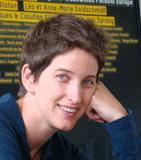You are here
Keystroke logging in a Windows environment via Inputlog
Date: Tuesday August 28
Time: 11:00 - 12:30
Location: 40
INSTRUCTOR RESUME
 Mariëlle Leijten is a post-doc researcher for the Flanders Research Foundation and is situated at the University of Antwerp.
Mariëlle Leijten is a post-doc researcher for the Flanders Research Foundation and is situated at the University of Antwerp.
 Luuk van Waes is a full professor at the University of Antwerp. They are the founders of the keystroke logging tool Inputlog.
Luuk van Waes is a full professor at the University of Antwerp. They are the founders of the keystroke logging tool Inputlog.
Their main research field is Writing and Digital Media (writing from multiple sources, speech recognition, cognitive models, on-line writing centers). They both teach business communication, research methods and digital communication in the Master in Multilingual Professional Communication at the University of Antwerp. The presenters have organized an international summer school on Writing Process Research: Keystroke logging and Eye tracking in 2011. In 2012 they are invited to present keystroke logging techniques at an international PhD training school at the University of Barcelona.
www.ua.ac.be/marielle.leijten - www.ua.ac.be/luuk.vanwaes
BENEFITS OF THE TUTORIAL
In this tutorial you will learn how to use the keystroke logging program Inputlog (www.inputlog.net). Inputlog is a keystroke logging tool that is developed at the University of Antwerp since 2003 and is used by 300 researcher worldwide. Recently the architecture of the program has been completely revised and new functionalities have been added. At the moment Inputlog consists of five modules:
- a data collection module that registers digital writing processes on a very detailed level;
- a data analysis module that offers basic and more advanced statistical analyses (e.g. text and pause analysis);
- a playback module that replays the recorded writing session;
- a convert and (5) merge module that allows data conversion and merging of data files from previous logging sessions and other observation tools (e.g. Tobii eyetracking data, Observer or Morae usability data).
Inputlog is used in the field of various types of writing process research: professional writing, developmental writing, L1-L2 writing, translation studies, etc.
FEATURES
The main objectives of this tutorial are:
- explore the possibilities and limitations of new methods and techniques that are currently used to collect data on writing processes, viz. keystroke logging (and eye tracking);
- discuss good practices to set up ethnographic and experimental writing process research, also focusing on the complementarity of observation methods;
- introduce various analyzing techniques, i.c. general logging data, pause analysis, revision analysis;
- llustrate integration (and complementarity) of Inputlog data with data from other observation tools and research techniques (e.g., eyetracking data, usability data, retrospective interviews);
- illustrate advanced analysis techniques used in recent case studies on 'writing from multiple digital sources' (e.g. Twitter, document design in professional writing environments).
AUDIENCE
This tutorial is intended for researchers who intend to or who are already conducting writing process studies. There will be no requirement regarding prior knowledge other than a strong interest in writing from a broad point of view. Novice researchers in the field will be provided with an overview of state-of-the-art research techniques in the domain of writing research, and the non-novice will certainly also profit from expanding existing knowledge.
